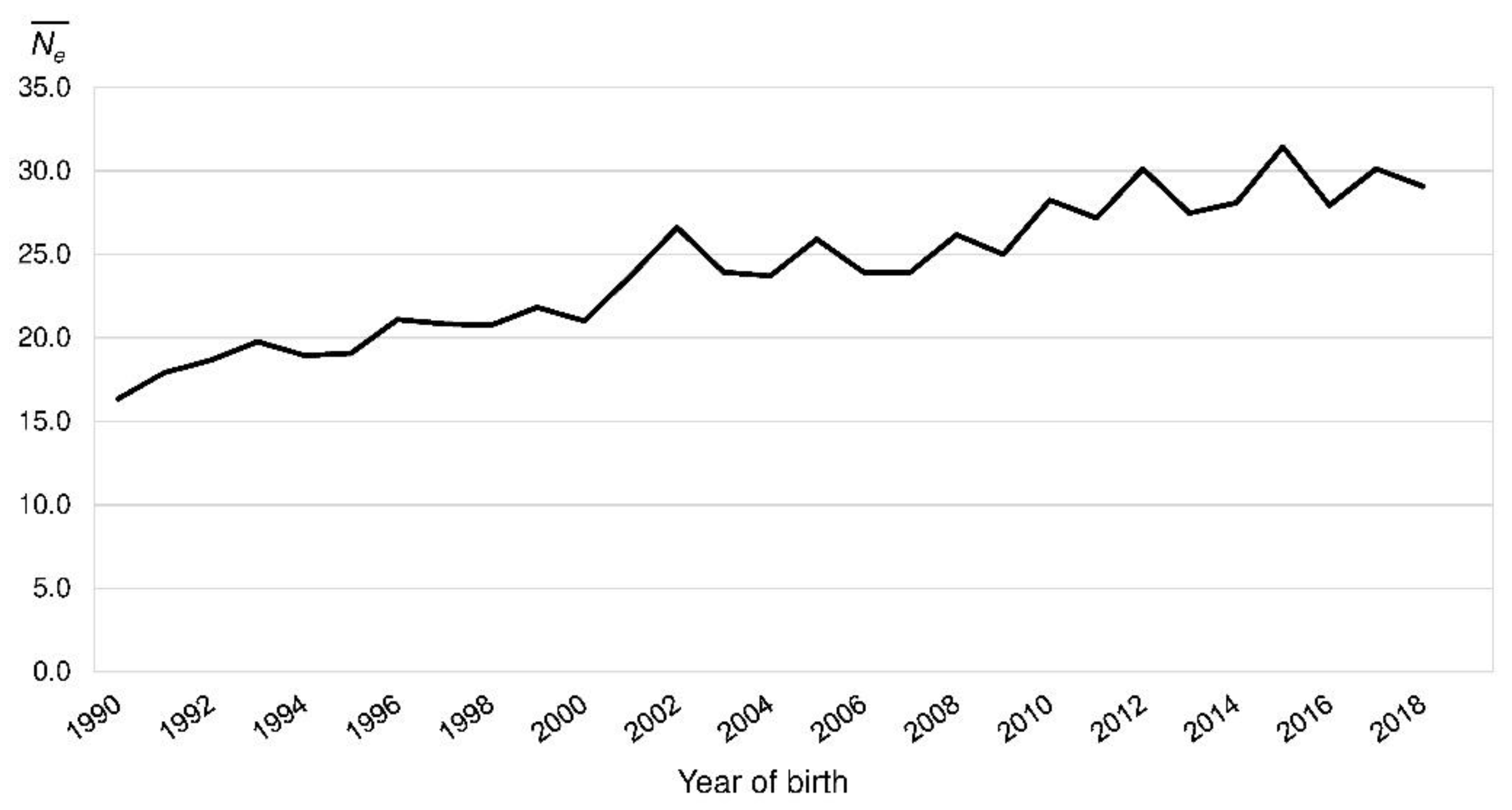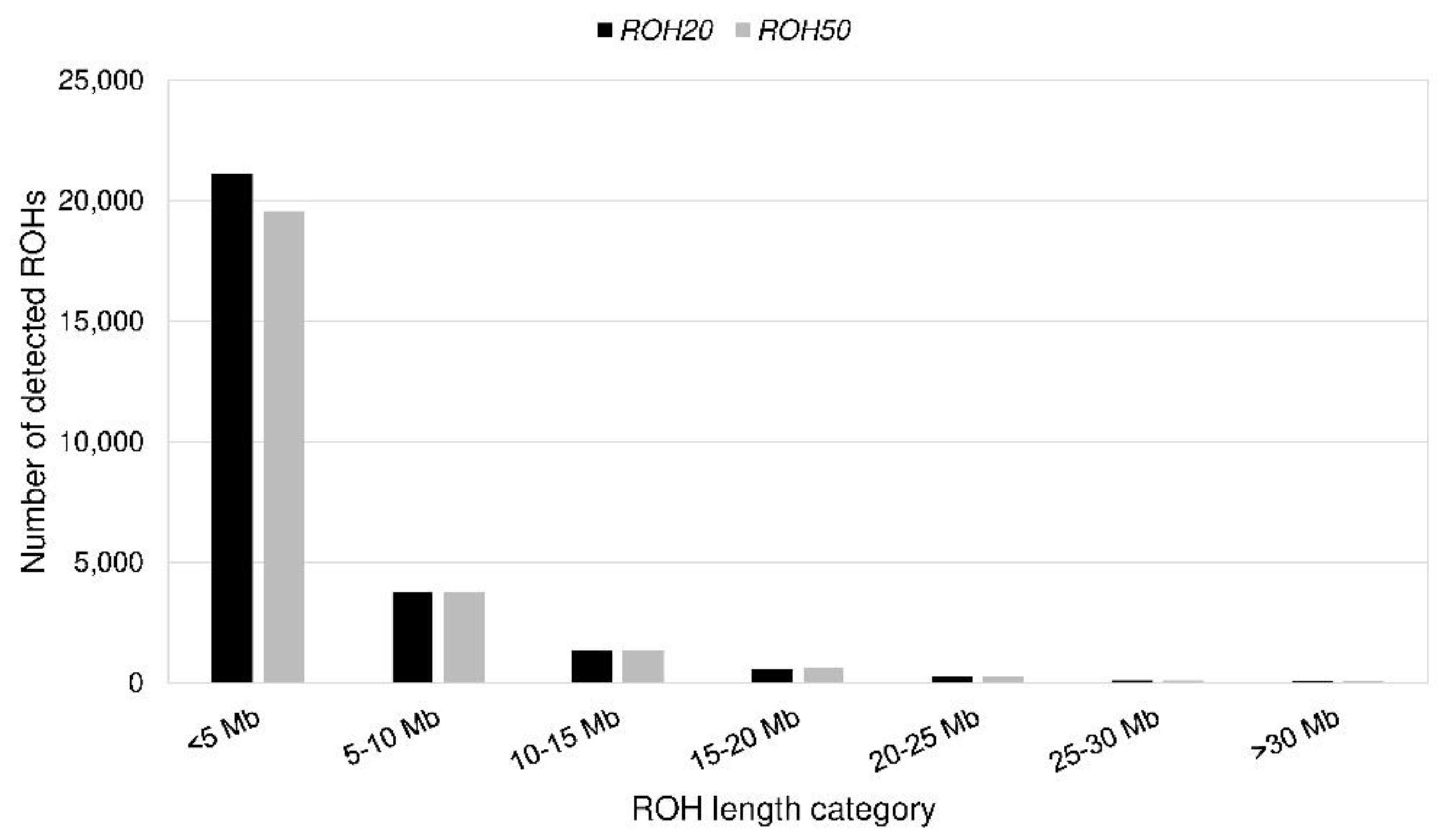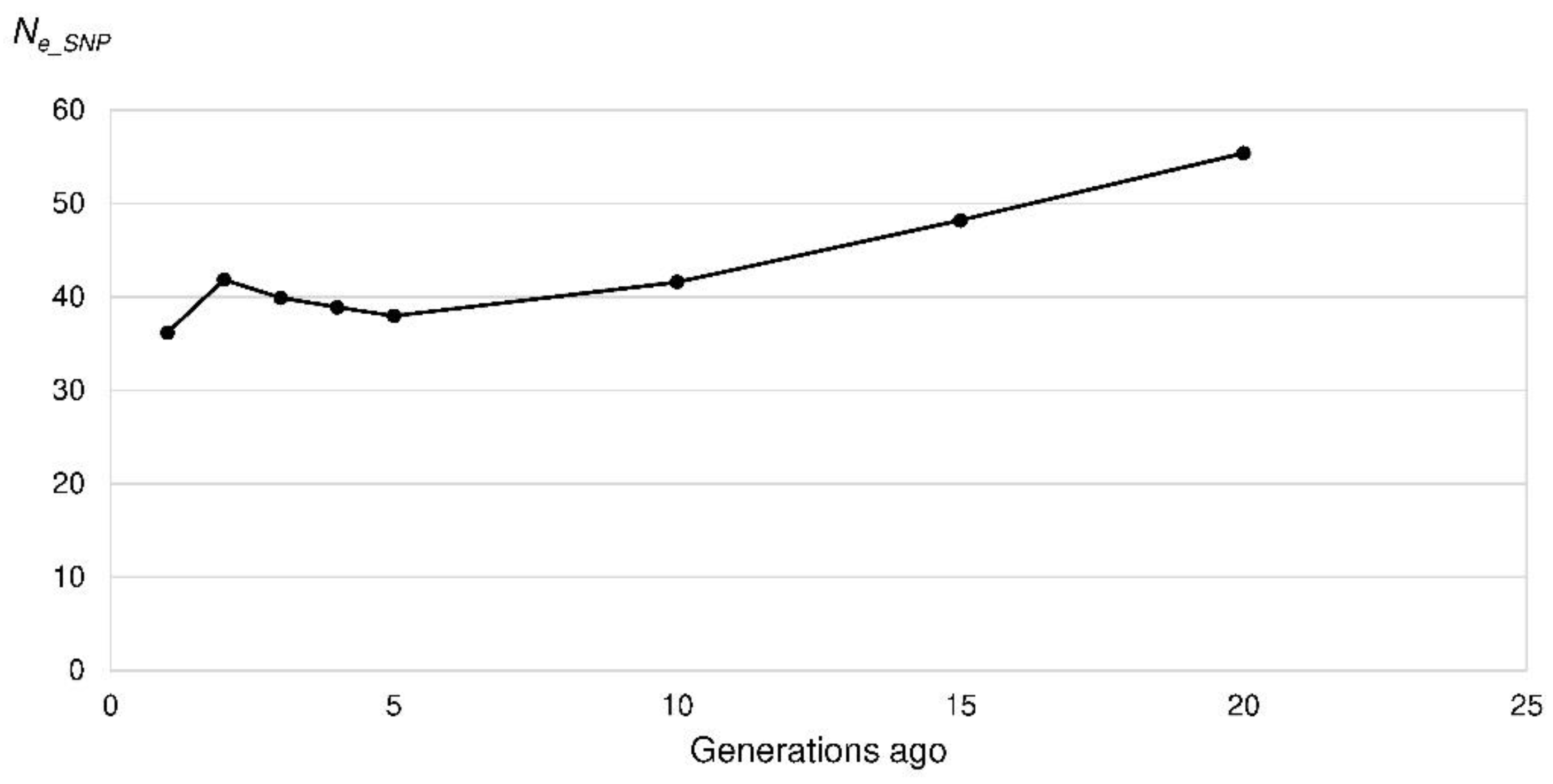Genetic Variability in Polish Lowland Sheepdogs Assessed by Pedigree and Genomic Data
Simple Summary
Abstract
1. Introduction
2. Materials and Methods
2.1. Data, Samples, and Genotyping
2.2. Analysis of Pedigree Data
2.3. Statistical Analysis of Genomic Data
3. Results
3.1. Demographic Measures Using Pedigree Analyses
3.2. Measurement of Genetic Variability Using Genomic Data
3.3. PANTHER Statistical Overrepresentation Analysis and Functional Classification Test
4. Discussion
5. Conclusions
Supplementary Materials
Author Contributions
Funding
Acknowledgments
Conflicts of Interest
References
- Leroy, G.; Rognon, X.; Varlet, A.; Joffrin, C.; Verrier, E. Genetic variability in French dog breeds assessed by pedigree data. J. Anim. Breed. Genet. 2006, 123, 1–9. [Google Scholar] [CrossRef]
- Calboli, F.C.; Sampson, J.; Fretwell, N.; Balding, D.J. Population structure and inbreeding from pedigree analysis of purebred dogs. Genet. Soc. Am. 2008, 179, 593–601. [Google Scholar] [CrossRef]
- Wiener, P.; Sánchez-Molano, E.; Clements, D.N.; Woolliams, J.A.; Haskell, M.J.; Blott, S.C. Genomic data illuminates demography, genetic structure and selection of a popular dog breed. BMC Genom. 2017, 18, 609. [Google Scholar] [CrossRef]
- Kardos, M.; Luikart, G.; Allendorf, F.W. Measuring individual inbreeding in the age of genomics: Marker-based measures are better than pedigrees. Heredity 2015, 115, 63. [Google Scholar] [CrossRef]
- Ubbink, G.; Knol, B.; Bouw, J. The relationship between homozygosity and the occurrence of specific diseases in Bouvier Belge des Flandres dogs in the Netherlands: Inbreeding and disease in the bouvier dog. Vet. Q. 1992, 14, 137–140. [Google Scholar] [CrossRef]
- Statistic of Born Dogs in VDH. Available online: https://www.vdh.de/ueber-den-vdh/welpenstatistik/ (accessed on 23 April 2020).
- Räber, H. Enzyklopädie der Rassehunde; Franckh-Kosmos Verlag: Stuttgart, Germany, 1993. [Google Scholar]
- FCI Breeds Nomenclature. Available online: http://www.fci.be/en/nomenclature/POLISH-LOWLAND-SHEEPDOG-251.html (accessed on 23 April 2020).
- Shariflou, M.R.; James, J.W.; Nicholas, F.W.; Wade, C.M. A genealogical survey of Australian registered dog breeds. Vet. J. 2011, 189, 203–210. [Google Scholar] [CrossRef]
- Bell, J.; Cavanagh, K.; Tilley, L.; Smith, F.W. Veterinary Medical Guide to Dog and Cat Breeds; Teton NewMedia: Jackson, WY, USA, 2012. [Google Scholar]
- Polish Lowland Sheepdog Statistics. Available online: https://www.ofa.org/diseases/breed-statistics#detail (accessed on 24 July 2020).
- Svensson, M.; Olsén, L.; Winkler, P.A.; Petersen--Jones, S.M.; Bergström, T.; Garncarz, Y.; Narfström, K. Progressive retinal atrophy in the Polski Owczarek Nizinny dog: A clinical and genetic study. Vet. Ophthalmol. 2016, 19, 195–205. [Google Scholar] [CrossRef]
- Gutiérrez, J.; Goyache, F. A note on ENDOG: A computer program for analysing pedigree information. J. Anim. Breed. Genet. 2005, 122, 172–176. [Google Scholar] [CrossRef]
- Maignel, L.; Boichard, D.; Verrier, E. Genetic variability of French dairy breeds estimated from pedigree information. Interbull Bull. 1996, 14, 49. [Google Scholar]
- MacCluer, J.W.; Boyce, A.J.; Dyke, B.; Weitkamp, L.R.; Pfenning, D.W.; Parsons, C.J. Inbreeding and pedigree structure in Standardbred horses. J. Hered. 1983, 74, 394–399. [Google Scholar] [CrossRef]
- James, J. A note on selection differential and generation length when generations overlap. Anim. Sci. 1977, 24, 109–112. [Google Scholar] [CrossRef]
- Boichard, D.; Maignel, L.; Verrier, E. The value of using probabilities of gene origin to measure genetic variability in a population. Genet. Sel. Evol. 1997, 29, 5. [Google Scholar] [CrossRef]
- Lacy, R.C. Analysis of founder representation in pedigrees: Founder equivalents and founder genome equivalents. Zoo Biol. 1989, 8, 111–123. [Google Scholar] [CrossRef]
- Boichard, D. PEDIG: A fortran package for pedigree analysis suited for large populations. In Proceedings of the 7th World Congress on Genetics Applied to Livestock Production, Montpellier, France, 19–23 August 2020; pp. 525–528. [Google Scholar]
- Leroy, G.; Baumung, R. Mating practices and the dissemination of genetic disorders in domestic animals, based on the example of dog breeding. Anim. Genet. 2011, 42, 66–74. [Google Scholar] [CrossRef]
- Meuwissen, T.; Luo, Z. Computing inbreeding coefficients in large populations. Genet. Sel. Evol. 1992, 24, 305–313. [Google Scholar] [CrossRef]
- Wright, S. The relation of livestock breeding to theories of evolution. J. Anim. Sci. 1978, 46, 1192–1200. [Google Scholar] [CrossRef]
- Caballero, A.; Toro, M.A. Interrelations between effective population size and other pedigree tools for the management of conserved populations. Genet. Res. 2000, 75, 331–343. [Google Scholar] [CrossRef]
- Caballero, A.; Toro, M.A. Analysis of genetic diversity for the management of conserved subdivided populations. Conserv. Genet. 2002, 3, 289–299. [Google Scholar] [CrossRef]
- Gutiérrez, J.; Cervantes, I.; Goyache, F. Improving the estimation of realized effective population sizes in farm animals. J. Anim. Breed. Genet. 2009, 126, 327–332. [Google Scholar] [CrossRef]
- Cervantes, I.; Goyache, F.; Molina, A.; Valera, M.; Gutiérrez, J. Estimation of effective population size from the rate of coancestry in pedigreed populations. J. Anim. Breed. Genet. 2011, 128, 56–63. [Google Scholar] [CrossRef]
- Gutiérrez, J.P.; Cervantes, I.; Molina, A.; Valera, M.; Goyache, F. Individual increase in inbreeding allows estimating effective sizes from pedigrees. Genet. Sel. Evol. 2008, 40, 359. [Google Scholar] [CrossRef]
- Pfahler, S.; Distl, O. Effective Population Size, Extended Linkage Disequilibrium and Signatures of Selection in the Rare Dog Breed Lundehund. PLoS ONE 2015, 10, e0122680. [Google Scholar] [CrossRef]
- Chang, C.C.; Chow, C.C.; Tellier, L.C.; Vattikuti, S.; Purcell, S.M.; Lee, J.J. Second-generation PLINK: Rising to the challenge of larger and richer datasets. GigaScience 2015, 4, s13742-015. [Google Scholar] [CrossRef]
- Lencz, T.; Lambert, C.; DeRosse, P.; Burdick, K.E.; Morgan, T.V.; Kane, J.M.; Kucherlapati, R.; Malhotra, A.K. Runs of homozygosity reveal highly penetrant recessive loci in schizophrenia. Proc. Natl. Acad. Sci. USA 2007, 104, 19942–19947. [Google Scholar] [CrossRef]
- Purfield, D.C.; Berry, D.P.; McParland, S.; Bradley, D.G. Runs of homozygosity and population history in cattle. BMC Genet. 2012, 13, 70. [Google Scholar] [CrossRef]
- Howrigan, D.P.; Simonson, M.A.; Keller, M.C. Detecting autozygosity through runs of homozygosity: A comparison of three autozygosity detection algorithms. BMC Genom. 2011, 12, 460. [Google Scholar] [CrossRef]
- Vasiliadis, D.; Metzger, J.; Distl, O. Demographic assessment of the Dalmatian dog–effective population size, linkage disequilibrium and inbreeding coefficients. Canine Med. Genet. 2020, 7, 1–11. [Google Scholar] [CrossRef]
- Sams, A.J.; Boyko, A.R. Fine-scale resolution of runs of homozygosity reveal patterns of inbreeding and substantial overlap with recessive disease genotypes in domestic dogs. G3 Genes Genomes Genet. 2019, 9, 117–123. [Google Scholar] [CrossRef]
- FCI-Rassestandard Polski Owczarek Nizinny (Polski Owczarek Nizinny (PON)). Available online: https://www.vdh.de/welpen/mein-welpe/polski-owczarek-nizinny-pon (accessed on 15 May 2019).
- R Core Team. R: A Language and Environment for Statistical Computing; Version 3.6.3; R Foundation for Statistical Computing: Vienna, Austria, 2020. [Google Scholar]
- McQuillan, R.; Leutenegger, A.-L.; Abdel-Rahman, R.; Franklin, C.S.; Pericic, M.; Barac-Lauc, L.; Smolej-Narancic, N.; Janicijevic, B.; Polasek, O.; Tenesa, A. Runs of homozygosity in European populations. Am. J. Hum. Genet. 2008, 83, 359–372. [Google Scholar] [CrossRef]
- Purcell, S.; Neale, B.; Todd-Brown, K.; Thomas, L.; Ferreira, M.A.; Bender, D.; Maller, J.; Sklar, P.; De Bakker, P.I.; Daly, M.J. PLINK: A tool set for whole-genome association and population-based linkage analyses. Am. J. Hum. Genet. 2007, 81, 559–575. [Google Scholar] [CrossRef]
- Sved, J. Linkage disequilibrium and homozygosity of chromosome segments in finite populations. Theor. Popul. Biol. 1971, 2, 125–141. [Google Scholar] [CrossRef]
- Steinig, E.J.; Neuditschko, M.; Khatkar, M.S.; Raadsma, H.W.; Zenger, K.R. NetView P: A network visualization tool to unravel complex population structure using genome--wide SNPs. Mol. Ecol. Resour. 2016, 16, 216–227. [Google Scholar] [CrossRef] [PubMed]
- Neuditschko, M.; Khatkar, M.S.; Raadsma, H.W. NetView: A high-definition network-visualization approach to detect fine-scale population structures from genome-wide patterns of variation. PLoS ONE 2012, 7, e48375. [Google Scholar] [CrossRef] [PubMed]
- Shannon, P.; Markiel, A.; Ozier, O.; Baliga, N.S.; Wang, J.T.; Ramage, D.; Amin, N.; Schwikowski, B.; Ideker, T. Cytoscape: A software environment for integrated models of biomolecular interaction networks. Genome Res. 2003, 13, 2498–2504. [Google Scholar] [CrossRef]
- Mi, H.; Muruganujan, A.; Ebert, D.; Huang, X.; Thomas, P.D. PANTHER version 14: More genomes, a new PANTHER GO-slim and improvements in enrichment analysis tools. Nucleic Acids Res. 2018, 47, D419–D426. [Google Scholar] [CrossRef]
- McKusick-Nathans Institute of Genetic Medicine, Johns Hopkins University (Baltimore, MD). Online Mendelian Inheritance in Man, OMIM®. Available online: https://omim.org/ (accessed on 12 August 2020).
- Sydney School of Veterinary Science. Online Mendelian Inheritance in Animals, OMIA. Available online: https://omia.org/browse/ (accessed on 12 August 2020).
- Todhunter, R.J.; Mateescu, R.; Lust, G.; Burton-Wurster, N.I.; Dykes, N.L.; Bliss, S.P.; Williams, A.J.; Vernier-Singer, M.; Corey, E.; Harjes, C.; et al. Quantitative trait loci for hip dysplasia in a crossbreed canine pedigree. Mamm. Genome 2005, 16, 720–730. [Google Scholar] [CrossRef]
- Todhunter, R.J.; Garrison, S.J.; Jordan, J.; Hunter, L.; Castelhano, M.G.; Ash, K.; Meyers-Wallen, V.; Krotscheck, U.; Hayward, J.J.; Grenier, J. Gene expression in hip soft tissues in incipient canine hip dysplasia and osteoarthritis. J. Orthop. Res. 2019, 37, 313–324. [Google Scholar] [CrossRef]
- Liu, T.; Todhunter, R.J.; Wu, S.; Hou, W.; Mateescu, R.; Zhang, Z.; Burton-Wurster, N.I.; Acland, G.M.; Lust, G.; Wu, R. A random model for mapping imprinted quantitative trait loci in a structured pedigree: An implication for mapping canine hip dysplasia. Genomics 2007, 90, 276–284. [Google Scholar] [CrossRef]
- Marschall, Y.; Distl, O. Mapping quantitative trait loci for canine hip dysplasia in German Shepherd dogs. Mamm. Genome 2007, 18, 861–870. [Google Scholar] [CrossRef]
- Phavaphutanon, J.; Mateescu, R.G.; Tsai, K.L.; Schweitzer, P.A.; Corey, E.E.; Vernier-Singer, M.A.; Williams, A.J.; Dykes, N.L.; Murphy, K.E.; Lust, G.; et al. Evaluation of quantitative trait loci for hip dysplasia in Labrador Retrievers. Am. J. Vet. Res. 2009, 70, 1094–1101. [Google Scholar] [CrossRef]
- Fels, L.; Marschall, Y.; Philipp, U.; Distl, O. Multiple loci associated with canine hip dysplasia (CHD) in German shepherd dogs. Mamm. Genome 2014, 25, 262–269. [Google Scholar] [CrossRef] [PubMed]
- Fels, L.; Distl, O. Identification and Validation of Quantitative Trait Loci (QTL) for Canine Hip Dysplasia (CHD) in German Shepherd Dogs. PLoS ONE 2014, 9, e96618. [Google Scholar] [CrossRef] [PubMed]
- Johns Hopkins University, Baltimore, MD. Online Mendelian Inheritance in Man, OMIM®. MIM Number: 601667. Available online: https://omim.org/entry/601667?search=601667&highlight=601667 (accessed on 12 August 2020).
- Leroy, G.; Verrier, E.; Meriaux, J.-C.; Rognon, X. Genetic diversity of dog breeds: Within--breed diversity comparing genealogical and molecular data. Anim. Genet. 2009, 40, 323–332. [Google Scholar] [CrossRef]
- Mäki, K. Population structure and genetic diversity of worldwide Nova Scotia Duck Tolling Retriever and Lancashire Heeler dog populations. J. Anim. Breed. Genet. 2010, 127, 318–326. [Google Scholar] [CrossRef] [PubMed]
- Silió, L.; Rodríguez, M.; Fernández, A.; Barragán, C.; Benítez, R.; Óvilo, C.; Fernández, A. Measuring inbreeding and inbreeding depression on pig growth from pedigree or SNP-Derived metrics. J. Anim. Breed. Genet. 2013, 130, 349–360. [Google Scholar] [CrossRef]
- Zhang, Q.; Calus, M.P.; Guldbrandtsen, B.; Lund, M.S.; Sahana, G. Estimation of inbreeding using pedigree, 50k SNP chip genotypes and full sequence data in three cattle breeds. BMC Genet. 2015, 16, 88. [Google Scholar] [CrossRef]
- Bjelland, D.; Weigel, K.; Vukasinovic, N.; Nkrumah, J. Evaluation of inbreeding depression in Holstein cattle using whole-genome SNP markers and alternative measures of genomic inbreeding. J. Dairy Sci. 2013, 96, 4697–4706. [Google Scholar] [CrossRef]
- Lutaaya, B.E.; Misztal, I.; Bertrand, J.; Mabry, J. Inbreeding in populations with incomplete pedigrees. J. Anim. Breed. Genet. 1999, 116, 475–480. [Google Scholar] [CrossRef]
- Cassell, B.; Adamec, V.; Pearson, R. Effect of incomplete pedigrees on estimates of inbreeding and inbreeding depression for days to first service and summit milk yield in Holsteins and Jerseys. J. Dairy Sci. 2003, 86, 2967–2976. [Google Scholar] [CrossRef]
- Nourhaghighi, N.; Teichert-Kuliszewska, K.; Davis, J.; Stewart, D.J.; Nag, S. Altered expression of angiopoietins during blood-brain barrier breakdown and angiogenesis. Lab. Investig. 2003, 83, 1211–1222. [Google Scholar] [CrossRef]
- Alam, M.; Han, K.; Lee, D.; Ha, J.; Kim, J. Estimation of effective population size in the Sapsaree: A Korean native dog (Canis familiaris). Asian Australas. J. Anim. Sci. 2012, 25, 1063. [Google Scholar] [CrossRef]
- DGfZ. Empfehlungen zur Erhaltung genetischer Vielfalt bei einheimischen Nutztieren. Züchtungskunde 1991, 63, 426–430. [Google Scholar]
- Bijma, P. Long-Term Genetic Contributions: Prediction of Rates of Inbreeding and Genetic Gain in Selected Populations; Department of Animal Sciences, Wageningen University: Wageningen, The Netherlands, 2000. [Google Scholar]
- Simon, D.L.; Buchenauer, D. Genetic Diversity of European Livestock Breeds; Wageningen Pers: Wageningen, The Netherlands, 1993. [Google Scholar]








| Term for Definition | Thresholds | ||
|---|---|---|---|
| Length (kb) | Minimum SNPs | Maximum Missing SNPs | |
| ROH5 | 60 | 5 | 2 |
| ROH7 | 84 | 7 | 2 |
| ROH10 | 120 | 10 | 2 |
| ROH20 | 240 | 20 | 2 |
| ROH30 | 360 | 30 | 3 |
| ROH40 | 480 | 40 | 4 |
| ROH50 | 600 | 50 | 4 |
| ROH65 | 780 | 65 | 5 |
| ROH358 | 4300 | 358 | 5 |
| Inbreeding Measures | Population 1990–2018 | Genotyped PONs |
|---|---|---|
| Number of animals | 4920 | 153 |
| Mean FPed | 0.18 | 0.18 |
| Average coancestry | 0.17 | 0.19 |
| Mean FIS_Ped | 0.011 | −0.014 |
| Mean equivalent generations (EqG) | 10.09 | 11.23 |
| Completeness of ancestors in the 5th parental generation | 0.93–0.99 | 0.86–1.00 |
| Mean individual increase in inbreeding (ΔFPed_i) | 0.023 | 0.019 |
| Realized effective population size () (±SE) | 22.16 ± 1.46 | 26.17 ± 0.00 |
| Effective population size by paired increase in coancestry () (±SE) | – | 24.40 ± 0.44 |
| Number of founders (f) | 103 | 48 |
| Number of effective founders (fe) | 10 | 10 |
| Number of ancestors (a) | 102 | 29 |
| Number of effective ancestors (fa) | 6 | 6 |
| Number of ancestors explaining 55% of genetic diversity | 2 | 2 |
| Number of ancestors explaining 75% of genetic diversity | 5 | 5 |
| Founder genome equivalents (Ng) | 3.01 ± 0.65 | 2.81 ± 0.67 |
| Mean generation interval in years (±SE) | 4.67 ± 2.05 | 4.95 ± 1.82 |
| Definition ROH | Overall Number of ROHs | Length of Shortest ROH (Kb) | Mean Length of ROH (Mb) | Length of Longest ROH (Mb) | Average Cumulative Length of All ROHs (Mb) | Mean FROH (and Its Range) |
|---|---|---|---|---|---|---|
| ROH5 | 27,276 | 61.44 | 3.76 | 82.92 | 669.68 | 0.30 (0.12–0.46) |
| ROH7 | 27,274 | 94.39 | 3.76 | 82.92 | 669.67 | 0.30 (0.12–0.46) |
| ROH10 | 27,267 | 126.14 | 3.76 | 82.92 | 669.67 | 0.30 (0.12–0.46) |
| ROH20 | 27,249 | 241.70 | 3.76 | 82.92 | 669.65 | 0.30 (0.12–0.46) |
| ROH30 | 27,042 | 375.58 | 3.85 | 82.92 | 680.15 | 0.31 (0.16–0.47) |
| ROH40 | 27,114 | 480.66 | 3.86 | 82.92 | 684.87 | 0.31 (0.17–0.47) |
| ROH50 | 25,888 | 600.01 | 4.02 | 82.92 | 679.94 | 0.31 (0.16–0.47) |
| ROH65 | 21,391 | 780.29 | 4.72 | 82.92 | 659.32 | 0.30 (0.15–0.46) |
| ROH358 | 6764 | 4316.64 | 10.44 | 82.92 | 461.34 | 0.21 (0.00–0.41) |
| Definition ROH | n | Mean Length (kb) | Cumulative Length of All ROHs (Mb) |
|---|---|---|---|
| ROH5 | 8 | 731.68 | 5.85 |
| ROH7 | 8 | 731.68 | 5.85 |
| ROH10 | 8 | 731.68 | 5.85 |
| ROH20 | 8 | 731.68 | 5.85 |
| ROH30 | 8 | 778.55 | 6.23 |
| ROH40 | 8 | 778.50 | 6.23 |
| ROH50 | 7 | 813.26 | 5.69 |
| ROH65 | 4 | 881.86 | 3.53 |
| ROH358 | 0 | - | - |
| Inbreeding Measures | FPED | FIS_SNP | FROH5/7/10/20 | FROH30 | FROH40 | FROH50 | FROH65 | FROH358 |
|---|---|---|---|---|---|---|---|---|
| FPED | 1 | 0.50 | 0.35 | 0.39 | 0.42 | 0.41 | 0.39 | 0.25 |
| FIS_SNP | 0.50 | 1 | 0.82 | 0.89 | 0.92 | 0.91 | 0.89 | 0.57 |
| FROH5/7/10/20 | 0.35 | 0.82 | 1 | 0.99 | 0.97 | 0.98 | 0.99 | 0.88 |
| FROH30 | 0.39 | 0.89 | 0.99 | 1 | 1 | 1 | 1 | 0.82 |
| FROH40 | 0.42 | 0.92 | 0.97 | 1 | 1 | 1 | 1 | 0.79 |
| FROH50 | 0.41 | 0.91 | 0.98 | 1 | 1 | 1 | 1 | 0.80 |
| FROH65 | 0.39 | 0.89 | 0.99 | 1 | 1 | 1 | 1 | 0.83 |
| FROH358 | 0.25 | 0.57 | 0.88 | 0.82 | 0.79 | 0.80 | 0.83 | 1 |
| Complete Generations | All | >3 | >4 | >5 | >6 |
|---|---|---|---|---|---|
| Correlation FROH20 | 0.35 | 0.37 | 0.40 | 0.40 | 0.46 |
| Correlation FROH50 | 0.41 | 0.42 | 0.46 | 0.46 | 0.52 |
| N | 153 | 151 | 142 | 113 | 89 |
© 2020 by the authors. Licensee MDPI, Basel, Switzerland. This article is an open access article distributed under the terms and conditions of the Creative Commons Attribution (CC BY) license (http://creativecommons.org/licenses/by/4.0/).
Share and Cite
Michels, P.W.; Distl, O. Genetic Variability in Polish Lowland Sheepdogs Assessed by Pedigree and Genomic Data. Animals 2020, 10, 1520. https://doi.org/10.3390/ani10091520
Michels PW, Distl O. Genetic Variability in Polish Lowland Sheepdogs Assessed by Pedigree and Genomic Data. Animals. 2020; 10(9):1520. https://doi.org/10.3390/ani10091520
Chicago/Turabian StyleMichels, Paula Wiebke, and Ottmar Distl. 2020. "Genetic Variability in Polish Lowland Sheepdogs Assessed by Pedigree and Genomic Data" Animals 10, no. 9: 1520. https://doi.org/10.3390/ani10091520
APA StyleMichels, P. W., & Distl, O. (2020). Genetic Variability in Polish Lowland Sheepdogs Assessed by Pedigree and Genomic Data. Animals, 10(9), 1520. https://doi.org/10.3390/ani10091520





